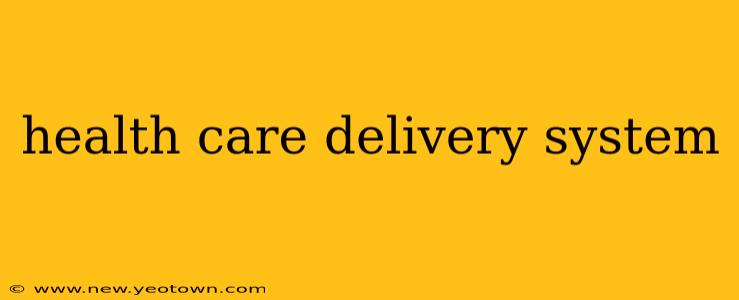The healthcare delivery system. It's a phrase that conjures up images of bustling hospitals, dedicated doctors, and complex insurance forms – a system so vital yet often so confusing. But what is a healthcare delivery system, exactly? It's more than just the sum of its parts; it's a complex interplay of people, processes, and technologies designed to provide healthcare services to a population. This journey will unravel the intricacies of this system, exploring its various models, challenges, and the future it holds.
What is a Healthcare Delivery System?
Imagine a vast network, constantly adapting and evolving. That's a healthcare delivery system. It encompasses all the entities and activities involved in providing healthcare, from the initial contact with a physician to ongoing management of chronic conditions. This includes hospitals, clinics, doctors' offices, pharmacies, insurance companies, and even the patients themselves. Think of it as a carefully orchestrated symphony, where each instrument (provider, payer, patient) plays a crucial role in creating a harmonious – or sometimes dissonant – healthcare experience.
How Does a Healthcare Delivery System Work?
The system's effectiveness hinges on the seamless integration of several key components:
- Providers: These are the healthcare professionals – doctors, nurses, therapists, etc. – who deliver direct patient care.
- Payers: Insurance companies, government programs (Medicare, Medicaid), and self-payers are the financial engines of the system, determining who gets reimbursed for services.
- Patients: The individuals receiving care, actively participating in their treatment plans and navigating the complexities of the system.
- Technology: Electronic health records, telehealth platforms, and medical devices are increasingly crucial for efficient and effective care.
The interaction between these elements dictates the overall efficiency and quality of care. A well-functioning system ensures timely access to quality services, optimal patient outcomes, and reasonable costs. However, the reality is often far more nuanced.
What are the Different Types of Healthcare Delivery Systems?
Several models exist, each with its own strengths and weaknesses:
- Fee-for-service: Providers bill for each service rendered, creating an incentive to provide more services, regardless of necessity.
- Managed care: These systems (HMOs, PPOs) integrate financing and delivery of care, aiming to control costs and improve quality through coordination of services.
- Integrated delivery systems: These networks combine various providers under a single umbrella, creating a more cohesive and coordinated care approach.
- Accountable care organizations (ACOs): Groups of healthcare providers who voluntarily work together to provide coordinated, high-quality care to their Medicare patients.
The choice of model often depends on factors like geographic location, payer mix, and the specific needs of the population being served.
What are the Challenges Faced by Healthcare Delivery Systems?
The path to providing excellent care is fraught with hurdles:
- High Costs: Healthcare costs in many countries are unsustainable, demanding continuous efforts to control expenses.
- Access to Care: Geographic location, insurance coverage, and affordability all create barriers to accessing necessary care.
- Quality of Care: Variations in quality of care necessitate ongoing efforts to standardize practices and improve outcomes.
- Administrative Burden: Navigating the complexities of insurance claims, billing, and regulations places an enormous burden on providers.
- Health disparities: Differences in access, quality, and outcomes exist among various population groups.
What is the Future of Healthcare Delivery Systems?
The future of healthcare delivery is dynamic and rapidly evolving:
- Increased focus on value-based care: Shifting from fee-for-service to rewarding providers for achieving positive patient outcomes.
- Technological advancements: Telehealth, AI, and data analytics are transforming how care is delivered and managed.
- Emphasis on prevention and wellness: Proactive measures to prevent illness are becoming more critical than reactive treatment.
- Personalized medicine: Tailoring treatment plans based on individual patient characteristics.
- Data-driven decision making: Leveraging data to optimize resource allocation and improve care delivery.
How Can Healthcare Delivery Systems be Improved?
Improving the system requires a multi-pronged approach:
- Increased transparency and accountability: Providing patients with greater access to information about cost and quality of care.
- Strengthening primary care: Investing in primary care providers as the foundation of a strong healthcare system.
- Promoting interoperability: Facilitating seamless data exchange between providers and payers.
- Addressing social determinants of health: Recognizing and addressing the social, economic, and environmental factors influencing health.
- Investing in workforce development: Training and retaining a skilled healthcare workforce to meet future needs.
The journey towards a truly effective and equitable healthcare delivery system is an ongoing one, requiring collaboration, innovation, and a steadfast commitment to improving the health and well-being of all. It's a complex system, but understanding its intricacies is the first step towards positive change.

